Theoretical Perspectives In Operations Management
VerifiedAdded on 2022/09/08
|14
|4468
|15
AI Summary
Contribute Materials
Your contribution can guide someone’s learning journey. Share your
documents today.
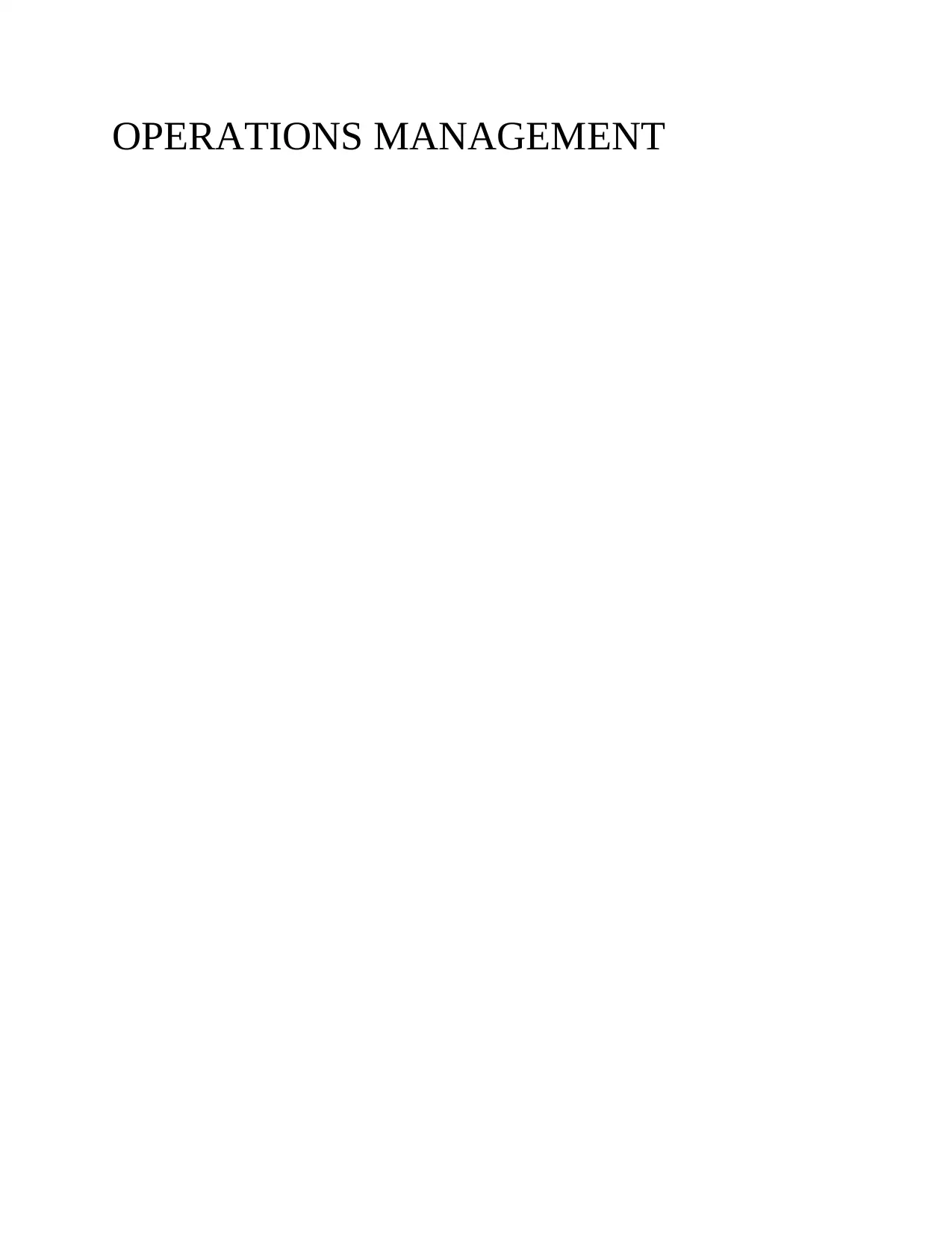
OPERATIONS MANAGEMENT
Secure Best Marks with AI Grader
Need help grading? Try our AI Grader for instant feedback on your assignments.
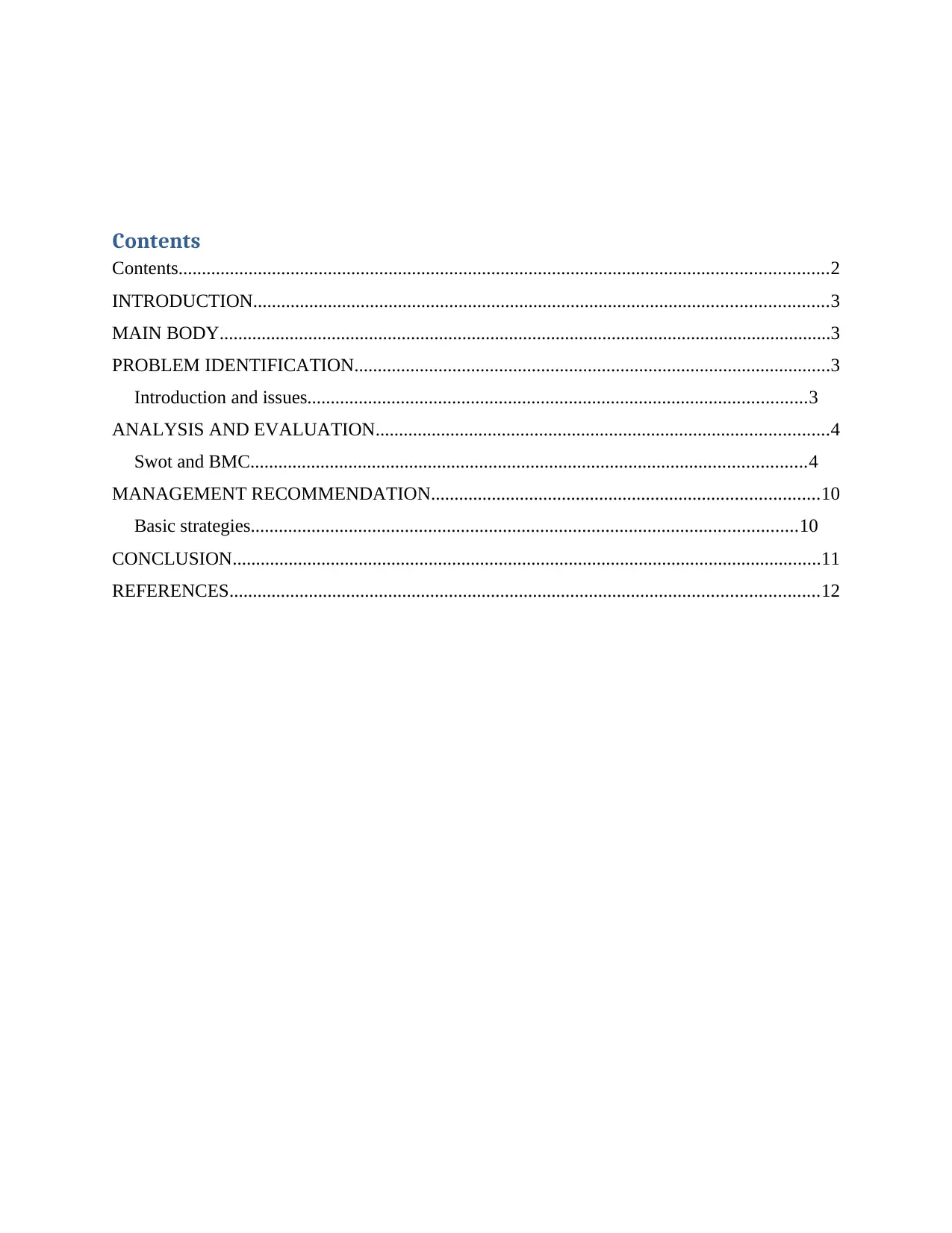
Contents
Contents...........................................................................................................................................2
INTRODUCTION...........................................................................................................................3
MAIN BODY...................................................................................................................................3
PROBLEM IDENTIFICATION......................................................................................................3
Introduction and issues...........................................................................................................3
ANALYSIS AND EVALUATION.................................................................................................4
Swot and BMC.......................................................................................................................4
MANAGEMENT RECOMMENDATION...................................................................................10
Basic strategies.....................................................................................................................10
CONCLUSION..............................................................................................................................11
REFERENCES..............................................................................................................................12
Contents...........................................................................................................................................2
INTRODUCTION...........................................................................................................................3
MAIN BODY...................................................................................................................................3
PROBLEM IDENTIFICATION......................................................................................................3
Introduction and issues...........................................................................................................3
ANALYSIS AND EVALUATION.................................................................................................4
Swot and BMC.......................................................................................................................4
MANAGEMENT RECOMMENDATION...................................................................................10
Basic strategies.....................................................................................................................10
CONCLUSION..............................................................................................................................11
REFERENCES..............................................................................................................................12
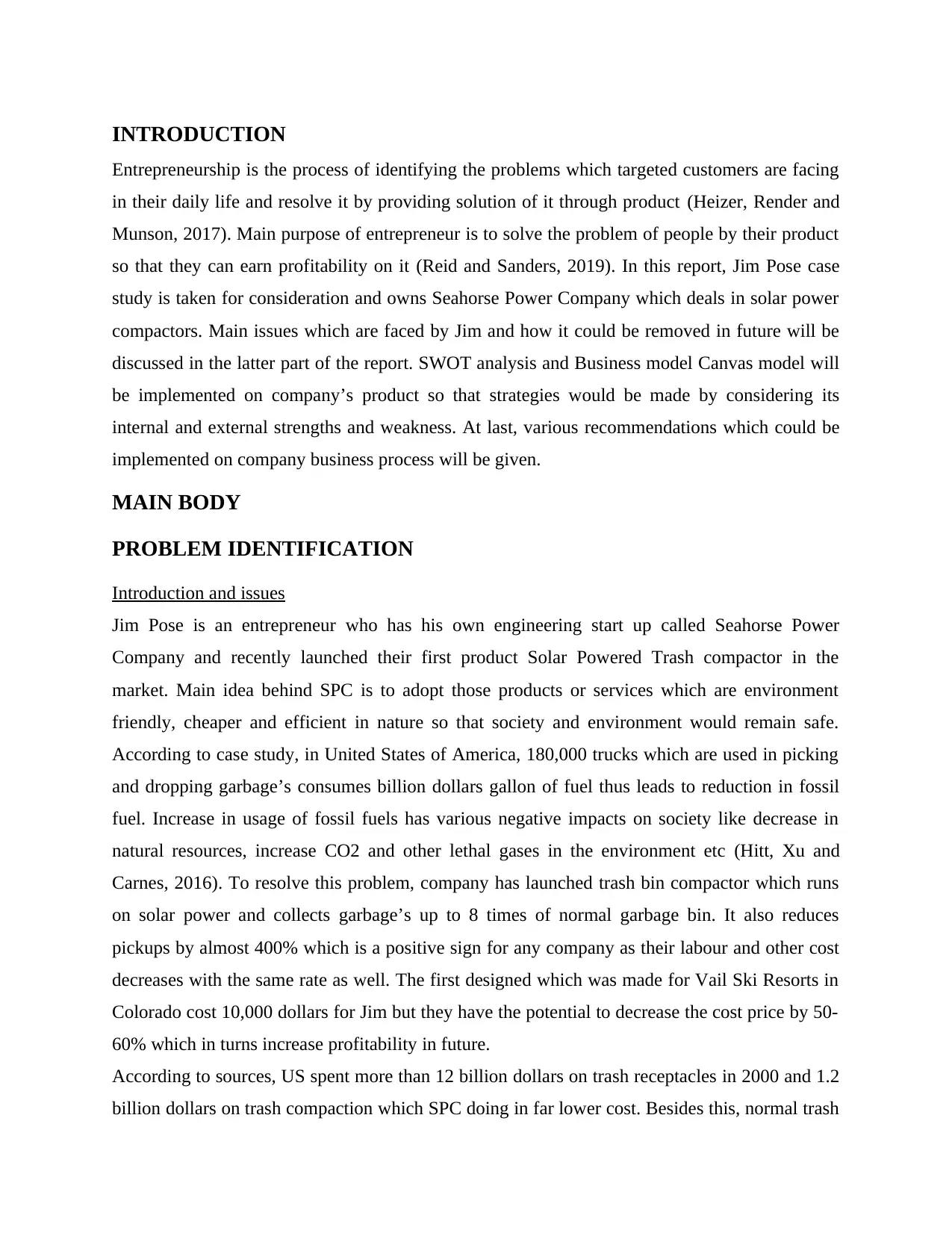
INTRODUCTION
Entrepreneurship is the process of identifying the problems which targeted customers are facing
in their daily life and resolve it by providing solution of it through product (Heizer, Render and
Munson, 2017). Main purpose of entrepreneur is to solve the problem of people by their product
so that they can earn profitability on it (Reid and Sanders, 2019). In this report, Jim Pose case
study is taken for consideration and owns Seahorse Power Company which deals in solar power
compactors. Main issues which are faced by Jim and how it could be removed in future will be
discussed in the latter part of the report. SWOT analysis and Business model Canvas model will
be implemented on company’s product so that strategies would be made by considering its
internal and external strengths and weakness. At last, various recommendations which could be
implemented on company business process will be given.
MAIN BODY
PROBLEM IDENTIFICATION
Introduction and issues
Jim Pose is an entrepreneur who has his own engineering start up called Seahorse Power
Company and recently launched their first product Solar Powered Trash compactor in the
market. Main idea behind SPC is to adopt those products or services which are environment
friendly, cheaper and efficient in nature so that society and environment would remain safe.
According to case study, in United States of America, 180,000 trucks which are used in picking
and dropping garbage’s consumes billion dollars gallon of fuel thus leads to reduction in fossil
fuel. Increase in usage of fossil fuels has various negative impacts on society like decrease in
natural resources, increase CO2 and other lethal gases in the environment etc (Hitt, Xu and
Carnes, 2016). To resolve this problem, company has launched trash bin compactor which runs
on solar power and collects garbage’s up to 8 times of normal garbage bin. It also reduces
pickups by almost 400% which is a positive sign for any company as their labour and other cost
decreases with the same rate as well. The first designed which was made for Vail Ski Resorts in
Colorado cost 10,000 dollars for Jim but they have the potential to decrease the cost price by 50-
60% which in turns increase profitability in future.
According to sources, US spent more than 12 billion dollars on trash receptacles in 2000 and 1.2
billion dollars on trash compaction which SPC doing in far lower cost. Besides this, normal trash
Entrepreneurship is the process of identifying the problems which targeted customers are facing
in their daily life and resolve it by providing solution of it through product (Heizer, Render and
Munson, 2017). Main purpose of entrepreneur is to solve the problem of people by their product
so that they can earn profitability on it (Reid and Sanders, 2019). In this report, Jim Pose case
study is taken for consideration and owns Seahorse Power Company which deals in solar power
compactors. Main issues which are faced by Jim and how it could be removed in future will be
discussed in the latter part of the report. SWOT analysis and Business model Canvas model will
be implemented on company’s product so that strategies would be made by considering its
internal and external strengths and weakness. At last, various recommendations which could be
implemented on company business process will be given.
MAIN BODY
PROBLEM IDENTIFICATION
Introduction and issues
Jim Pose is an entrepreneur who has his own engineering start up called Seahorse Power
Company and recently launched their first product Solar Powered Trash compactor in the
market. Main idea behind SPC is to adopt those products or services which are environment
friendly, cheaper and efficient in nature so that society and environment would remain safe.
According to case study, in United States of America, 180,000 trucks which are used in picking
and dropping garbage’s consumes billion dollars gallon of fuel thus leads to reduction in fossil
fuel. Increase in usage of fossil fuels has various negative impacts on society like decrease in
natural resources, increase CO2 and other lethal gases in the environment etc (Hitt, Xu and
Carnes, 2016). To resolve this problem, company has launched trash bin compactor which runs
on solar power and collects garbage’s up to 8 times of normal garbage bin. It also reduces
pickups by almost 400% which is a positive sign for any company as their labour and other cost
decreases with the same rate as well. The first designed which was made for Vail Ski Resorts in
Colorado cost 10,000 dollars for Jim but they have the potential to decrease the cost price by 50-
60% which in turns increase profitability in future.
According to sources, US spent more than 12 billion dollars on trash receptacles in 2000 and 1.2
billion dollars on trash compaction which SPC doing in far lower cost. Besides this, normal trash
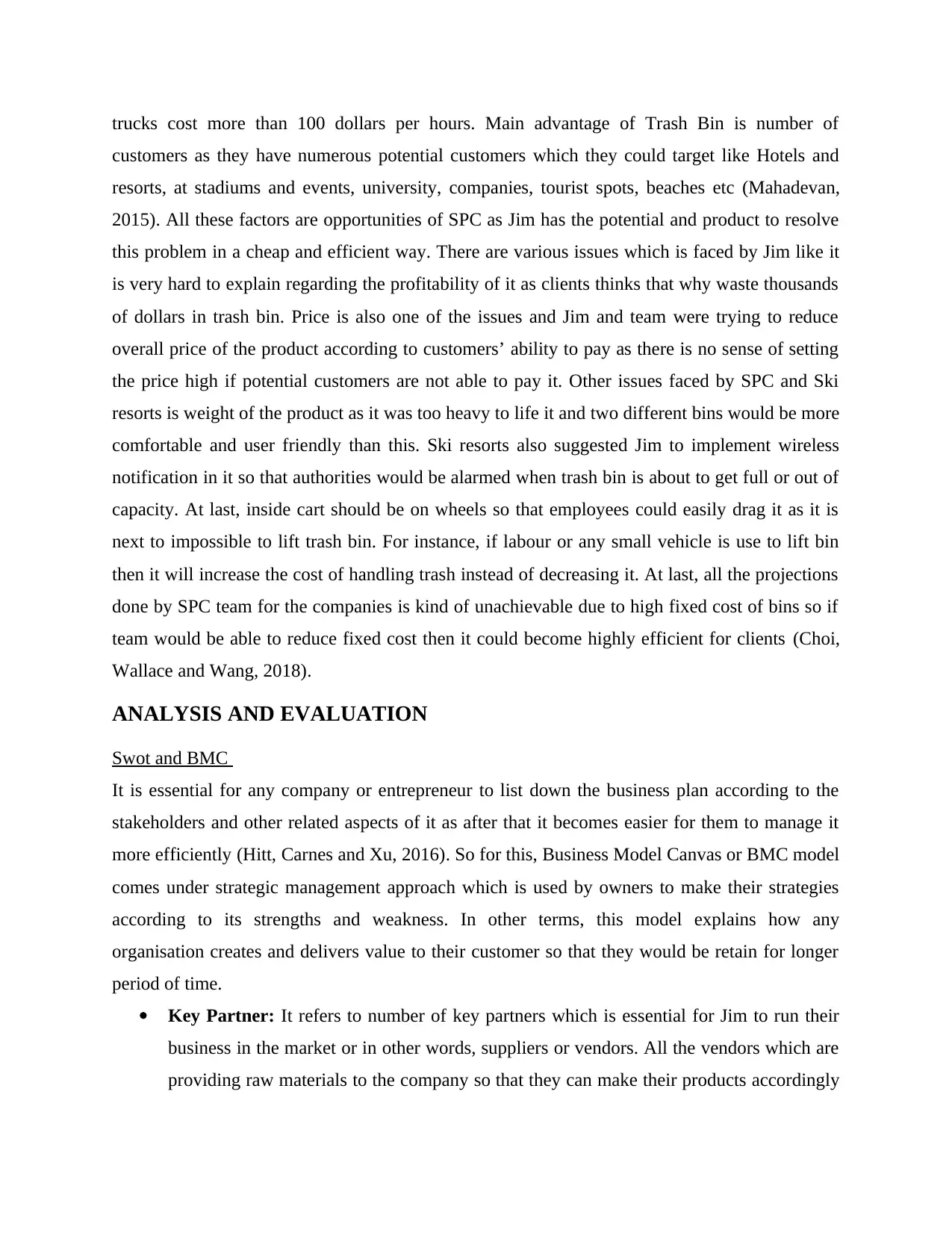
trucks cost more than 100 dollars per hours. Main advantage of Trash Bin is number of
customers as they have numerous potential customers which they could target like Hotels and
resorts, at stadiums and events, university, companies, tourist spots, beaches etc (Mahadevan,
2015). All these factors are opportunities of SPC as Jim has the potential and product to resolve
this problem in a cheap and efficient way. There are various issues which is faced by Jim like it
is very hard to explain regarding the profitability of it as clients thinks that why waste thousands
of dollars in trash bin. Price is also one of the issues and Jim and team were trying to reduce
overall price of the product according to customers’ ability to pay as there is no sense of setting
the price high if potential customers are not able to pay it. Other issues faced by SPC and Ski
resorts is weight of the product as it was too heavy to life it and two different bins would be more
comfortable and user friendly than this. Ski resorts also suggested Jim to implement wireless
notification in it so that authorities would be alarmed when trash bin is about to get full or out of
capacity. At last, inside cart should be on wheels so that employees could easily drag it as it is
next to impossible to lift trash bin. For instance, if labour or any small vehicle is use to lift bin
then it will increase the cost of handling trash instead of decreasing it. At last, all the projections
done by SPC team for the companies is kind of unachievable due to high fixed cost of bins so if
team would be able to reduce fixed cost then it could become highly efficient for clients (Choi,
Wallace and Wang, 2018).
ANALYSIS AND EVALUATION
Swot and BMC
It is essential for any company or entrepreneur to list down the business plan according to the
stakeholders and other related aspects of it as after that it becomes easier for them to manage it
more efficiently (Hitt, Carnes and Xu, 2016). So for this, Business Model Canvas or BMC model
comes under strategic management approach which is used by owners to make their strategies
according to its strengths and weakness. In other terms, this model explains how any
organisation creates and delivers value to their customer so that they would be retain for longer
period of time.
Key Partner: It refers to number of key partners which is essential for Jim to run their
business in the market or in other words, suppliers or vendors. All the vendors which are
providing raw materials to the company so that they can make their products accordingly
customers as they have numerous potential customers which they could target like Hotels and
resorts, at stadiums and events, university, companies, tourist spots, beaches etc (Mahadevan,
2015). All these factors are opportunities of SPC as Jim has the potential and product to resolve
this problem in a cheap and efficient way. There are various issues which is faced by Jim like it
is very hard to explain regarding the profitability of it as clients thinks that why waste thousands
of dollars in trash bin. Price is also one of the issues and Jim and team were trying to reduce
overall price of the product according to customers’ ability to pay as there is no sense of setting
the price high if potential customers are not able to pay it. Other issues faced by SPC and Ski
resorts is weight of the product as it was too heavy to life it and two different bins would be more
comfortable and user friendly than this. Ski resorts also suggested Jim to implement wireless
notification in it so that authorities would be alarmed when trash bin is about to get full or out of
capacity. At last, inside cart should be on wheels so that employees could easily drag it as it is
next to impossible to lift trash bin. For instance, if labour or any small vehicle is use to lift bin
then it will increase the cost of handling trash instead of decreasing it. At last, all the projections
done by SPC team for the companies is kind of unachievable due to high fixed cost of bins so if
team would be able to reduce fixed cost then it could become highly efficient for clients (Choi,
Wallace and Wang, 2018).
ANALYSIS AND EVALUATION
Swot and BMC
It is essential for any company or entrepreneur to list down the business plan according to the
stakeholders and other related aspects of it as after that it becomes easier for them to manage it
more efficiently (Hitt, Carnes and Xu, 2016). So for this, Business Model Canvas or BMC model
comes under strategic management approach which is used by owners to make their strategies
according to its strengths and weakness. In other terms, this model explains how any
organisation creates and delivers value to their customer so that they would be retain for longer
period of time.
Key Partner: It refers to number of key partners which is essential for Jim to run their
business in the market or in other words, suppliers or vendors. All the vendors which are
providing raw materials to the company so that they can make their products accordingly
Secure Best Marks with AI Grader
Need help grading? Try our AI Grader for instant feedback on your assignments.
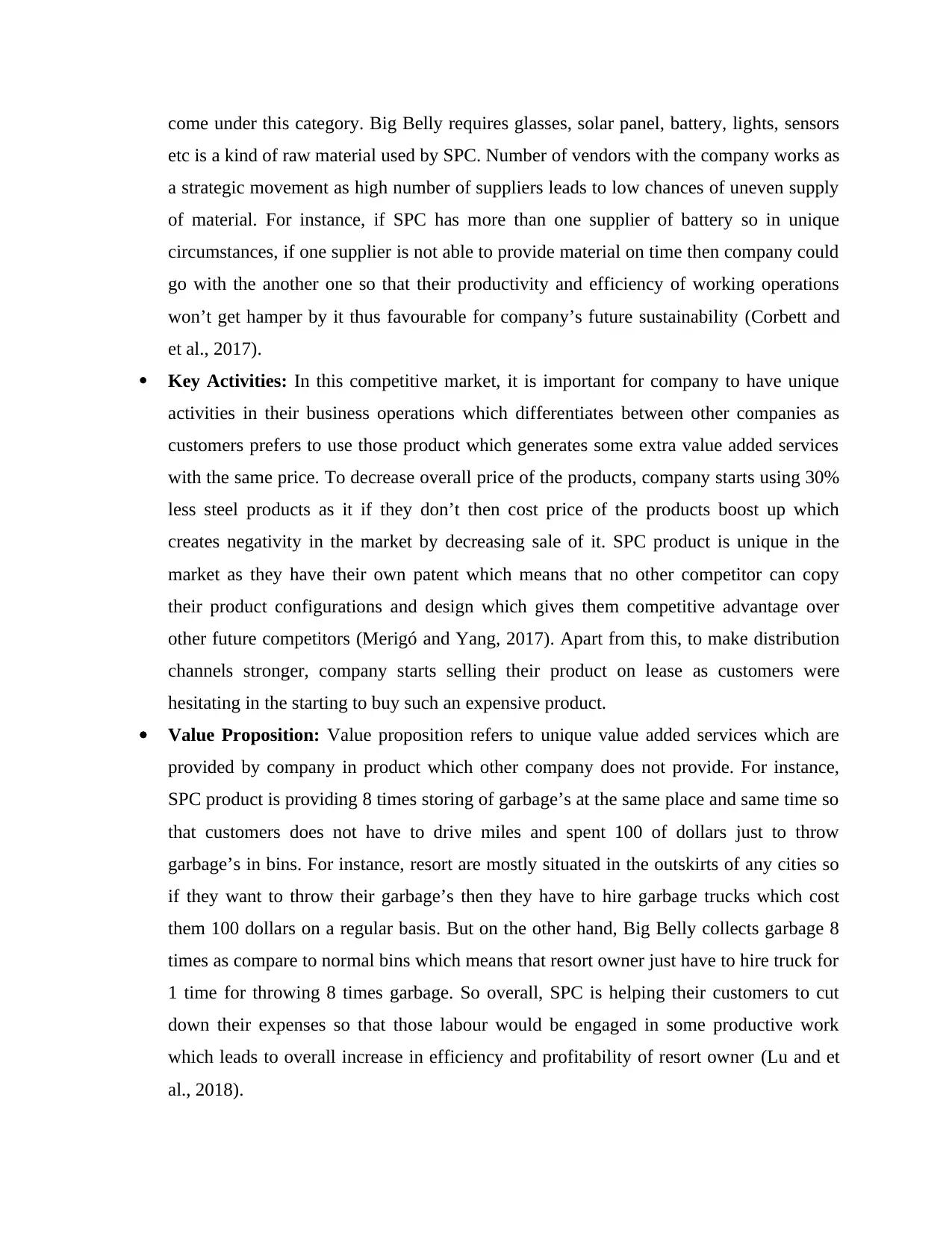
come under this category. Big Belly requires glasses, solar panel, battery, lights, sensors
etc is a kind of raw material used by SPC. Number of vendors with the company works as
a strategic movement as high number of suppliers leads to low chances of uneven supply
of material. For instance, if SPC has more than one supplier of battery so in unique
circumstances, if one supplier is not able to provide material on time then company could
go with the another one so that their productivity and efficiency of working operations
won’t get hamper by it thus favourable for company’s future sustainability (Corbett and
et al., 2017).
Key Activities: In this competitive market, it is important for company to have unique
activities in their business operations which differentiates between other companies as
customers prefers to use those product which generates some extra value added services
with the same price. To decrease overall price of the products, company starts using 30%
less steel products as it if they don’t then cost price of the products boost up which
creates negativity in the market by decreasing sale of it. SPC product is unique in the
market as they have their own patent which means that no other competitor can copy
their product configurations and design which gives them competitive advantage over
other future competitors (Merigó and Yang, 2017). Apart from this, to make distribution
channels stronger, company starts selling their product on lease as customers were
hesitating in the starting to buy such an expensive product.
Value Proposition: Value proposition refers to unique value added services which are
provided by company in product which other company does not provide. For instance,
SPC product is providing 8 times storing of garbage’s at the same place and same time so
that customers does not have to drive miles and spent 100 of dollars just to throw
garbage’s in bins. For instance, resort are mostly situated in the outskirts of any cities so
if they want to throw their garbage’s then they have to hire garbage trucks which cost
them 100 dollars on a regular basis. But on the other hand, Big Belly collects garbage 8
times as compare to normal bins which means that resort owner just have to hire truck for
1 time for throwing 8 times garbage. So overall, SPC is helping their customers to cut
down their expenses so that those labour would be engaged in some productive work
which leads to overall increase in efficiency and profitability of resort owner (Lu and et
al., 2018).
etc is a kind of raw material used by SPC. Number of vendors with the company works as
a strategic movement as high number of suppliers leads to low chances of uneven supply
of material. For instance, if SPC has more than one supplier of battery so in unique
circumstances, if one supplier is not able to provide material on time then company could
go with the another one so that their productivity and efficiency of working operations
won’t get hamper by it thus favourable for company’s future sustainability (Corbett and
et al., 2017).
Key Activities: In this competitive market, it is important for company to have unique
activities in their business operations which differentiates between other companies as
customers prefers to use those product which generates some extra value added services
with the same price. To decrease overall price of the products, company starts using 30%
less steel products as it if they don’t then cost price of the products boost up which
creates negativity in the market by decreasing sale of it. SPC product is unique in the
market as they have their own patent which means that no other competitor can copy
their product configurations and design which gives them competitive advantage over
other future competitors (Merigó and Yang, 2017). Apart from this, to make distribution
channels stronger, company starts selling their product on lease as customers were
hesitating in the starting to buy such an expensive product.
Value Proposition: Value proposition refers to unique value added services which are
provided by company in product which other company does not provide. For instance,
SPC product is providing 8 times storing of garbage’s at the same place and same time so
that customers does not have to drive miles and spent 100 of dollars just to throw
garbage’s in bins. For instance, resort are mostly situated in the outskirts of any cities so
if they want to throw their garbage’s then they have to hire garbage trucks which cost
them 100 dollars on a regular basis. But on the other hand, Big Belly collects garbage 8
times as compare to normal bins which means that resort owner just have to hire truck for
1 time for throwing 8 times garbage. So overall, SPC is helping their customers to cut
down their expenses so that those labour would be engaged in some productive work
which leads to overall increase in efficiency and profitability of resort owner (Lu and et
al., 2018).
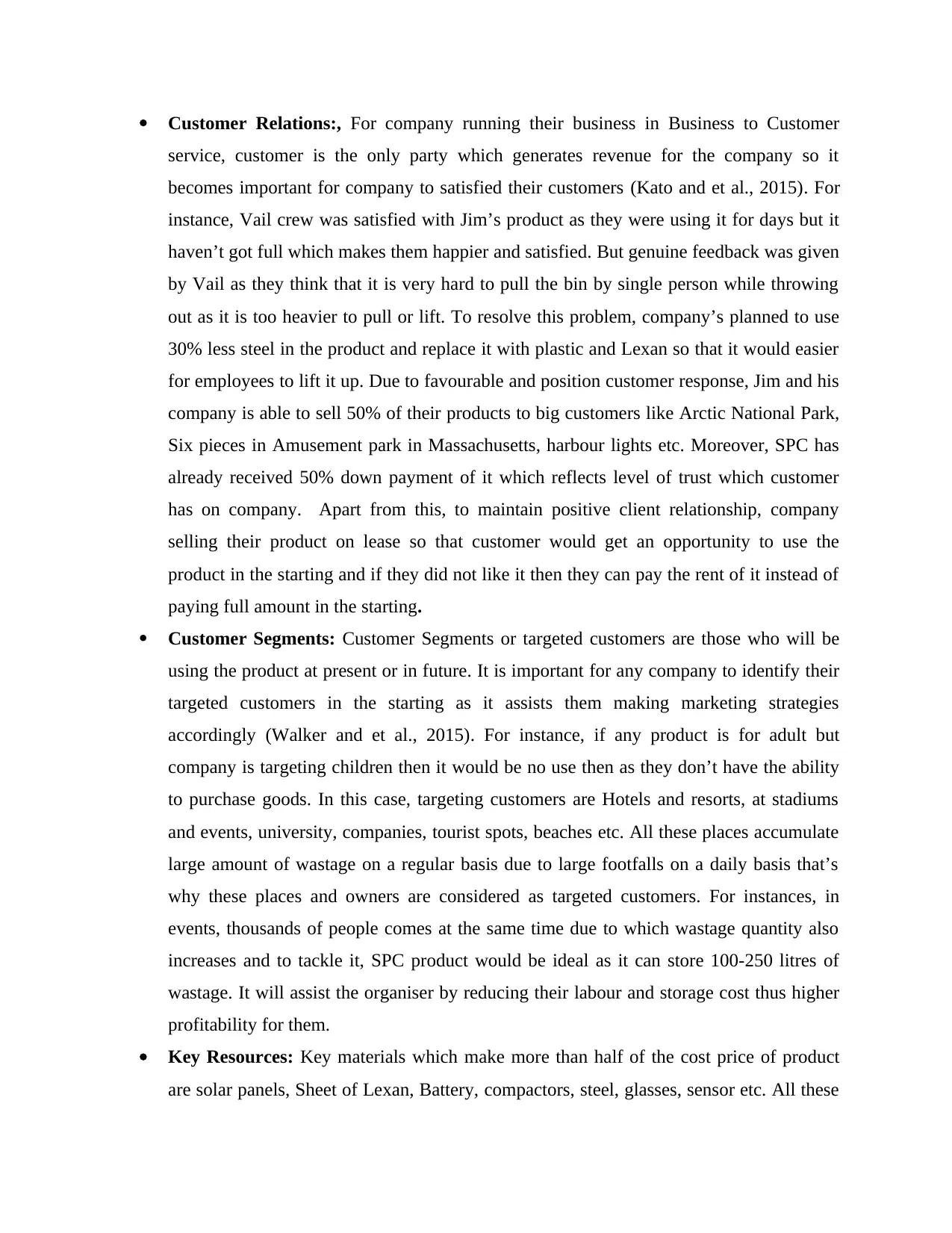
Customer Relations:, For company running their business in Business to Customer
service, customer is the only party which generates revenue for the company so it
becomes important for company to satisfied their customers (Kato and et al., 2015). For
instance, Vail crew was satisfied with Jim’s product as they were using it for days but it
haven’t got full which makes them happier and satisfied. But genuine feedback was given
by Vail as they think that it is very hard to pull the bin by single person while throwing
out as it is too heavier to pull or lift. To resolve this problem, company’s planned to use
30% less steel in the product and replace it with plastic and Lexan so that it would easier
for employees to lift it up. Due to favourable and position customer response, Jim and his
company is able to sell 50% of their products to big customers like Arctic National Park,
Six pieces in Amusement park in Massachusetts, harbour lights etc. Moreover, SPC has
already received 50% down payment of it which reflects level of trust which customer
has on company. Apart from this, to maintain positive client relationship, company
selling their product on lease so that customer would get an opportunity to use the
product in the starting and if they did not like it then they can pay the rent of it instead of
paying full amount in the starting.
Customer Segments: Customer Segments or targeted customers are those who will be
using the product at present or in future. It is important for any company to identify their
targeted customers in the starting as it assists them making marketing strategies
accordingly (Walker and et al., 2015). For instance, if any product is for adult but
company is targeting children then it would be no use then as they don’t have the ability
to purchase goods. In this case, targeting customers are Hotels and resorts, at stadiums
and events, university, companies, tourist spots, beaches etc. All these places accumulate
large amount of wastage on a regular basis due to large footfalls on a daily basis that’s
why these places and owners are considered as targeted customers. For instances, in
events, thousands of people comes at the same time due to which wastage quantity also
increases and to tackle it, SPC product would be ideal as it can store 100-250 litres of
wastage. It will assist the organiser by reducing their labour and storage cost thus higher
profitability for them.
Key Resources: Key materials which make more than half of the cost price of product
are solar panels, Sheet of Lexan, Battery, compactors, steel, glasses, sensor etc. All these
service, customer is the only party which generates revenue for the company so it
becomes important for company to satisfied their customers (Kato and et al., 2015). For
instance, Vail crew was satisfied with Jim’s product as they were using it for days but it
haven’t got full which makes them happier and satisfied. But genuine feedback was given
by Vail as they think that it is very hard to pull the bin by single person while throwing
out as it is too heavier to pull or lift. To resolve this problem, company’s planned to use
30% less steel in the product and replace it with plastic and Lexan so that it would easier
for employees to lift it up. Due to favourable and position customer response, Jim and his
company is able to sell 50% of their products to big customers like Arctic National Park,
Six pieces in Amusement park in Massachusetts, harbour lights etc. Moreover, SPC has
already received 50% down payment of it which reflects level of trust which customer
has on company. Apart from this, to maintain positive client relationship, company
selling their product on lease so that customer would get an opportunity to use the
product in the starting and if they did not like it then they can pay the rent of it instead of
paying full amount in the starting.
Customer Segments: Customer Segments or targeted customers are those who will be
using the product at present or in future. It is important for any company to identify their
targeted customers in the starting as it assists them making marketing strategies
accordingly (Walker and et al., 2015). For instance, if any product is for adult but
company is targeting children then it would be no use then as they don’t have the ability
to purchase goods. In this case, targeting customers are Hotels and resorts, at stadiums
and events, university, companies, tourist spots, beaches etc. All these places accumulate
large amount of wastage on a regular basis due to large footfalls on a daily basis that’s
why these places and owners are considered as targeted customers. For instances, in
events, thousands of people comes at the same time due to which wastage quantity also
increases and to tackle it, SPC product would be ideal as it can store 100-250 litres of
wastage. It will assist the organiser by reducing their labour and storage cost thus higher
profitability for them.
Key Resources: Key materials which make more than half of the cost price of product
are solar panels, Sheet of Lexan, Battery, compactors, steel, glasses, sensor etc. All these
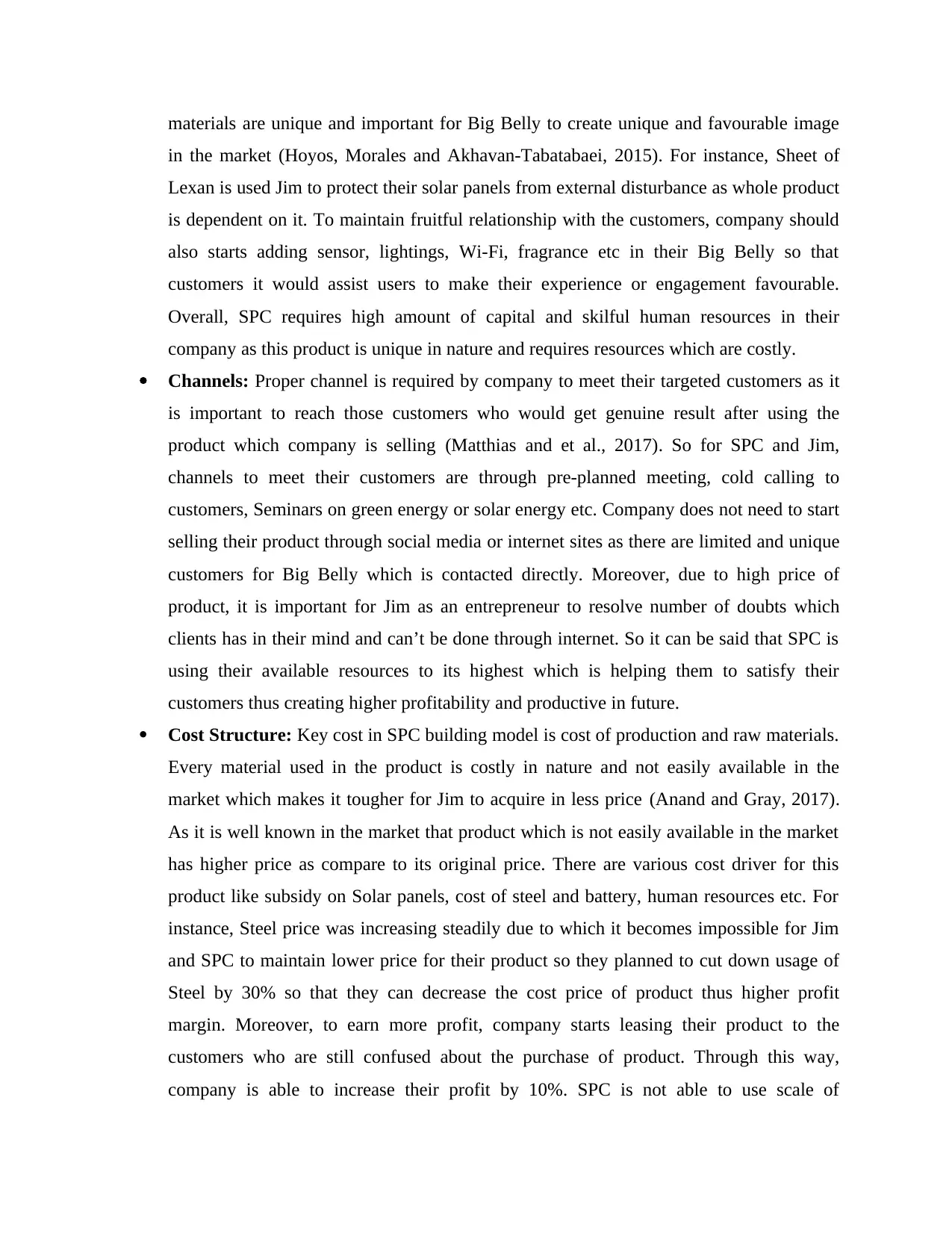
materials are unique and important for Big Belly to create unique and favourable image
in the market (Hoyos, Morales and Akhavan-Tabatabaei, 2015). For instance, Sheet of
Lexan is used Jim to protect their solar panels from external disturbance as whole product
is dependent on it. To maintain fruitful relationship with the customers, company should
also starts adding sensor, lightings, Wi-Fi, fragrance etc in their Big Belly so that
customers it would assist users to make their experience or engagement favourable.
Overall, SPC requires high amount of capital and skilful human resources in their
company as this product is unique in nature and requires resources which are costly.
Channels: Proper channel is required by company to meet their targeted customers as it
is important to reach those customers who would get genuine result after using the
product which company is selling (Matthias and et al., 2017). So for SPC and Jim,
channels to meet their customers are through pre-planned meeting, cold calling to
customers, Seminars on green energy or solar energy etc. Company does not need to start
selling their product through social media or internet sites as there are limited and unique
customers for Big Belly which is contacted directly. Moreover, due to high price of
product, it is important for Jim as an entrepreneur to resolve number of doubts which
clients has in their mind and can’t be done through internet. So it can be said that SPC is
using their available resources to its highest which is helping them to satisfy their
customers thus creating higher profitability and productive in future.
Cost Structure: Key cost in SPC building model is cost of production and raw materials.
Every material used in the product is costly in nature and not easily available in the
market which makes it tougher for Jim to acquire in less price (Anand and Gray, 2017).
As it is well known in the market that product which is not easily available in the market
has higher price as compare to its original price. There are various cost driver for this
product like subsidy on Solar panels, cost of steel and battery, human resources etc. For
instance, Steel price was increasing steadily due to which it becomes impossible for Jim
and SPC to maintain lower price for their product so they planned to cut down usage of
Steel by 30% so that they can decrease the cost price of product thus higher profit
margin. Moreover, to earn more profit, company starts leasing their product to the
customers who are still confused about the purchase of product. Through this way,
company is able to increase their profit by 10%. SPC is not able to use scale of
in the market (Hoyos, Morales and Akhavan-Tabatabaei, 2015). For instance, Sheet of
Lexan is used Jim to protect their solar panels from external disturbance as whole product
is dependent on it. To maintain fruitful relationship with the customers, company should
also starts adding sensor, lightings, Wi-Fi, fragrance etc in their Big Belly so that
customers it would assist users to make their experience or engagement favourable.
Overall, SPC requires high amount of capital and skilful human resources in their
company as this product is unique in nature and requires resources which are costly.
Channels: Proper channel is required by company to meet their targeted customers as it
is important to reach those customers who would get genuine result after using the
product which company is selling (Matthias and et al., 2017). So for SPC and Jim,
channels to meet their customers are through pre-planned meeting, cold calling to
customers, Seminars on green energy or solar energy etc. Company does not need to start
selling their product through social media or internet sites as there are limited and unique
customers for Big Belly which is contacted directly. Moreover, due to high price of
product, it is important for Jim as an entrepreneur to resolve number of doubts which
clients has in their mind and can’t be done through internet. So it can be said that SPC is
using their available resources to its highest which is helping them to satisfy their
customers thus creating higher profitability and productive in future.
Cost Structure: Key cost in SPC building model is cost of production and raw materials.
Every material used in the product is costly in nature and not easily available in the
market which makes it tougher for Jim to acquire in less price (Anand and Gray, 2017).
As it is well known in the market that product which is not easily available in the market
has higher price as compare to its original price. There are various cost driver for this
product like subsidy on Solar panels, cost of steel and battery, human resources etc. For
instance, Steel price was increasing steadily due to which it becomes impossible for Jim
and SPC to maintain lower price for their product so they planned to cut down usage of
Steel by 30% so that they can decrease the cost price of product thus higher profit
margin. Moreover, to earn more profit, company starts leasing their product to the
customers who are still confused about the purchase of product. Through this way,
company is able to increase their profit by 10%. SPC is not able to use scale of
Paraphrase This Document
Need a fresh take? Get an instant paraphrase of this document with our AI Paraphraser
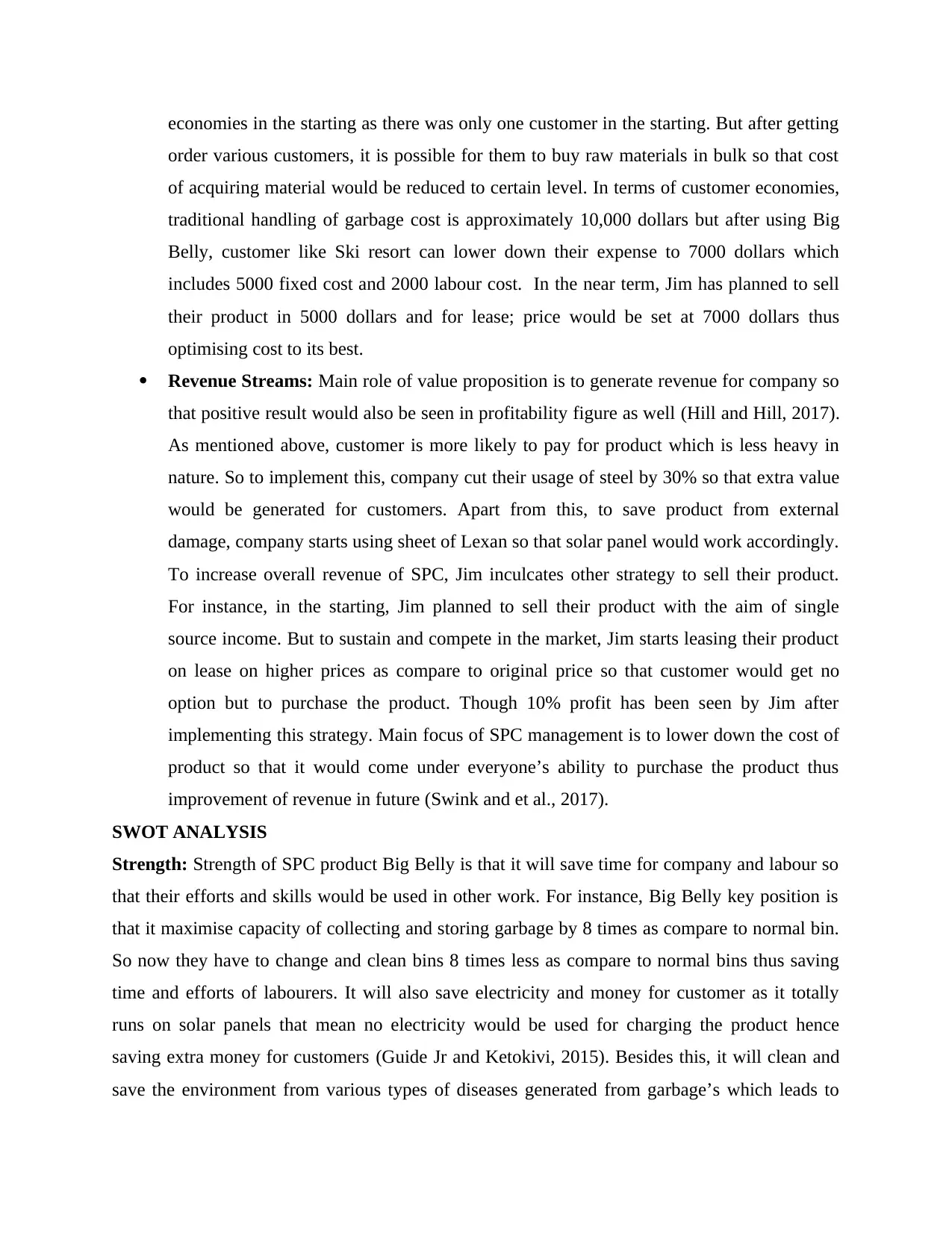
economies in the starting as there was only one customer in the starting. But after getting
order various customers, it is possible for them to buy raw materials in bulk so that cost
of acquiring material would be reduced to certain level. In terms of customer economies,
traditional handling of garbage cost is approximately 10,000 dollars but after using Big
Belly, customer like Ski resort can lower down their expense to 7000 dollars which
includes 5000 fixed cost and 2000 labour cost. In the near term, Jim has planned to sell
their product in 5000 dollars and for lease; price would be set at 7000 dollars thus
optimising cost to its best.
Revenue Streams: Main role of value proposition is to generate revenue for company so
that positive result would also be seen in profitability figure as well (Hill and Hill, 2017).
As mentioned above, customer is more likely to pay for product which is less heavy in
nature. So to implement this, company cut their usage of steel by 30% so that extra value
would be generated for customers. Apart from this, to save product from external
damage, company starts using sheet of Lexan so that solar panel would work accordingly.
To increase overall revenue of SPC, Jim inculcates other strategy to sell their product.
For instance, in the starting, Jim planned to sell their product with the aim of single
source income. But to sustain and compete in the market, Jim starts leasing their product
on lease on higher prices as compare to original price so that customer would get no
option but to purchase the product. Though 10% profit has been seen by Jim after
implementing this strategy. Main focus of SPC management is to lower down the cost of
product so that it would come under everyone’s ability to purchase the product thus
improvement of revenue in future (Swink and et al., 2017).
SWOT ANALYSIS
Strength: Strength of SPC product Big Belly is that it will save time for company and labour so
that their efforts and skills would be used in other work. For instance, Big Belly key position is
that it maximise capacity of collecting and storing garbage by 8 times as compare to normal bin.
So now they have to change and clean bins 8 times less as compare to normal bins thus saving
time and efforts of labourers. It will also save electricity and money for customer as it totally
runs on solar panels that mean no electricity would be used for charging the product hence
saving extra money for customers (Guide Jr and Ketokivi, 2015). Besides this, it will clean and
save the environment from various types of diseases generated from garbage’s which leads to
order various customers, it is possible for them to buy raw materials in bulk so that cost
of acquiring material would be reduced to certain level. In terms of customer economies,
traditional handling of garbage cost is approximately 10,000 dollars but after using Big
Belly, customer like Ski resort can lower down their expense to 7000 dollars which
includes 5000 fixed cost and 2000 labour cost. In the near term, Jim has planned to sell
their product in 5000 dollars and for lease; price would be set at 7000 dollars thus
optimising cost to its best.
Revenue Streams: Main role of value proposition is to generate revenue for company so
that positive result would also be seen in profitability figure as well (Hill and Hill, 2017).
As mentioned above, customer is more likely to pay for product which is less heavy in
nature. So to implement this, company cut their usage of steel by 30% so that extra value
would be generated for customers. Apart from this, to save product from external
damage, company starts using sheet of Lexan so that solar panel would work accordingly.
To increase overall revenue of SPC, Jim inculcates other strategy to sell their product.
For instance, in the starting, Jim planned to sell their product with the aim of single
source income. But to sustain and compete in the market, Jim starts leasing their product
on lease on higher prices as compare to original price so that customer would get no
option but to purchase the product. Though 10% profit has been seen by Jim after
implementing this strategy. Main focus of SPC management is to lower down the cost of
product so that it would come under everyone’s ability to purchase the product thus
improvement of revenue in future (Swink and et al., 2017).
SWOT ANALYSIS
Strength: Strength of SPC product Big Belly is that it will save time for company and labour so
that their efforts and skills would be used in other work. For instance, Big Belly key position is
that it maximise capacity of collecting and storing garbage by 8 times as compare to normal bin.
So now they have to change and clean bins 8 times less as compare to normal bins thus saving
time and efforts of labourers. It will also save electricity and money for customer as it totally
runs on solar panels that mean no electricity would be used for charging the product hence
saving extra money for customers (Guide Jr and Ketokivi, 2015). Besides this, it will clean and
save the environment from various types of diseases generated from garbage’s which leads to
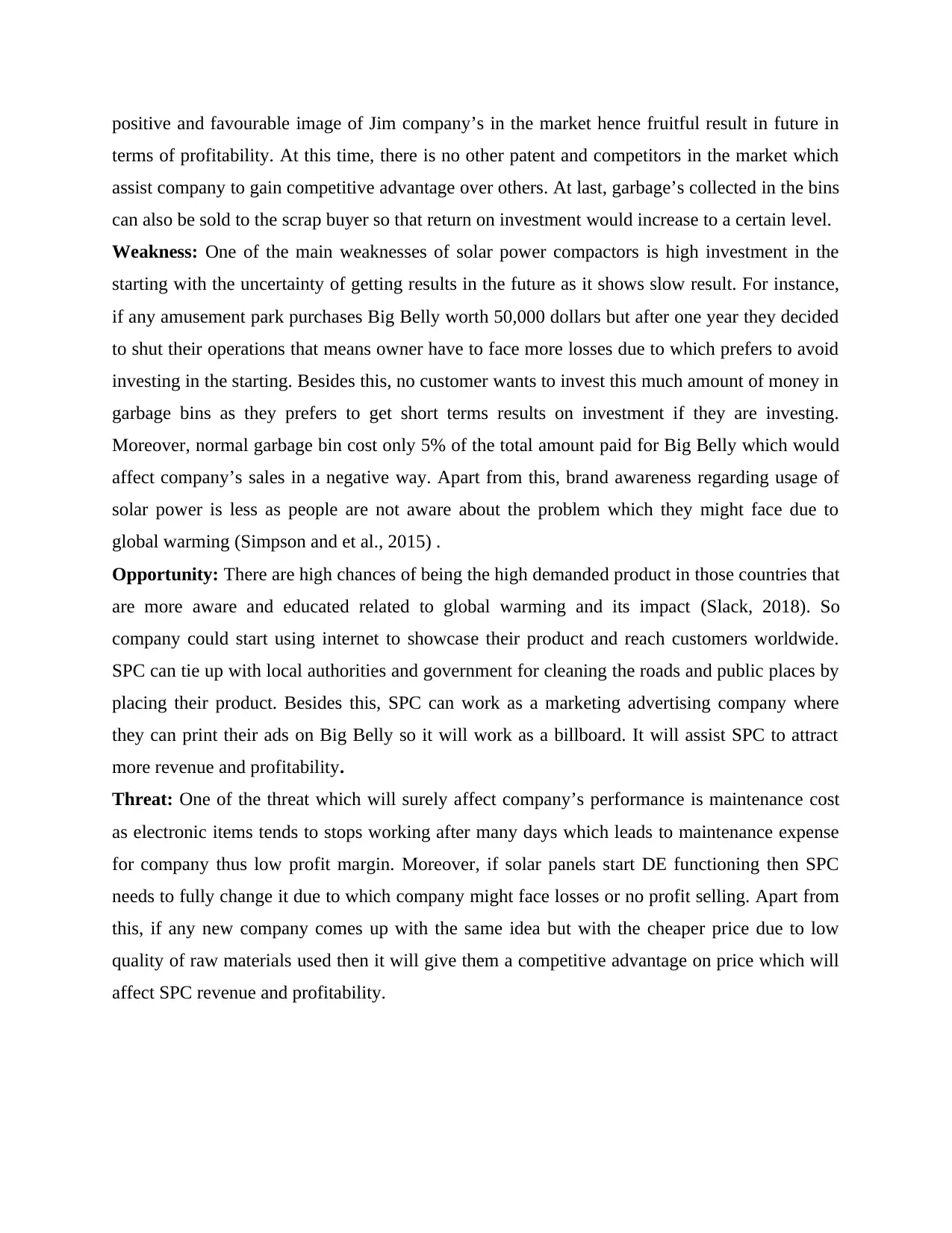
positive and favourable image of Jim company’s in the market hence fruitful result in future in
terms of profitability. At this time, there is no other patent and competitors in the market which
assist company to gain competitive advantage over others. At last, garbage’s collected in the bins
can also be sold to the scrap buyer so that return on investment would increase to a certain level.
Weakness: One of the main weaknesses of solar power compactors is high investment in the
starting with the uncertainty of getting results in the future as it shows slow result. For instance,
if any amusement park purchases Big Belly worth 50,000 dollars but after one year they decided
to shut their operations that means owner have to face more losses due to which prefers to avoid
investing in the starting. Besides this, no customer wants to invest this much amount of money in
garbage bins as they prefers to get short terms results on investment if they are investing.
Moreover, normal garbage bin cost only 5% of the total amount paid for Big Belly which would
affect company’s sales in a negative way. Apart from this, brand awareness regarding usage of
solar power is less as people are not aware about the problem which they might face due to
global warming (Simpson and et al., 2015) .
Opportunity: There are high chances of being the high demanded product in those countries that
are more aware and educated related to global warming and its impact (Slack, 2018). So
company could start using internet to showcase their product and reach customers worldwide.
SPC can tie up with local authorities and government for cleaning the roads and public places by
placing their product. Besides this, SPC can work as a marketing advertising company where
they can print their ads on Big Belly so it will work as a billboard. It will assist SPC to attract
more revenue and profitability.
Threat: One of the threat which will surely affect company’s performance is maintenance cost
as electronic items tends to stops working after many days which leads to maintenance expense
for company thus low profit margin. Moreover, if solar panels start DE functioning then SPC
needs to fully change it due to which company might face losses or no profit selling. Apart from
this, if any new company comes up with the same idea but with the cheaper price due to low
quality of raw materials used then it will give them a competitive advantage on price which will
affect SPC revenue and profitability.
terms of profitability. At this time, there is no other patent and competitors in the market which
assist company to gain competitive advantage over others. At last, garbage’s collected in the bins
can also be sold to the scrap buyer so that return on investment would increase to a certain level.
Weakness: One of the main weaknesses of solar power compactors is high investment in the
starting with the uncertainty of getting results in the future as it shows slow result. For instance,
if any amusement park purchases Big Belly worth 50,000 dollars but after one year they decided
to shut their operations that means owner have to face more losses due to which prefers to avoid
investing in the starting. Besides this, no customer wants to invest this much amount of money in
garbage bins as they prefers to get short terms results on investment if they are investing.
Moreover, normal garbage bin cost only 5% of the total amount paid for Big Belly which would
affect company’s sales in a negative way. Apart from this, brand awareness regarding usage of
solar power is less as people are not aware about the problem which they might face due to
global warming (Simpson and et al., 2015) .
Opportunity: There are high chances of being the high demanded product in those countries that
are more aware and educated related to global warming and its impact (Slack, 2018). So
company could start using internet to showcase their product and reach customers worldwide.
SPC can tie up with local authorities and government for cleaning the roads and public places by
placing their product. Besides this, SPC can work as a marketing advertising company where
they can print their ads on Big Belly so it will work as a billboard. It will assist SPC to attract
more revenue and profitability.
Threat: One of the threat which will surely affect company’s performance is maintenance cost
as electronic items tends to stops working after many days which leads to maintenance expense
for company thus low profit margin. Moreover, if solar panels start DE functioning then SPC
needs to fully change it due to which company might face losses or no profit selling. Apart from
this, if any new company comes up with the same idea but with the cheaper price due to low
quality of raw materials used then it will give them a competitive advantage on price which will
affect SPC revenue and profitability.
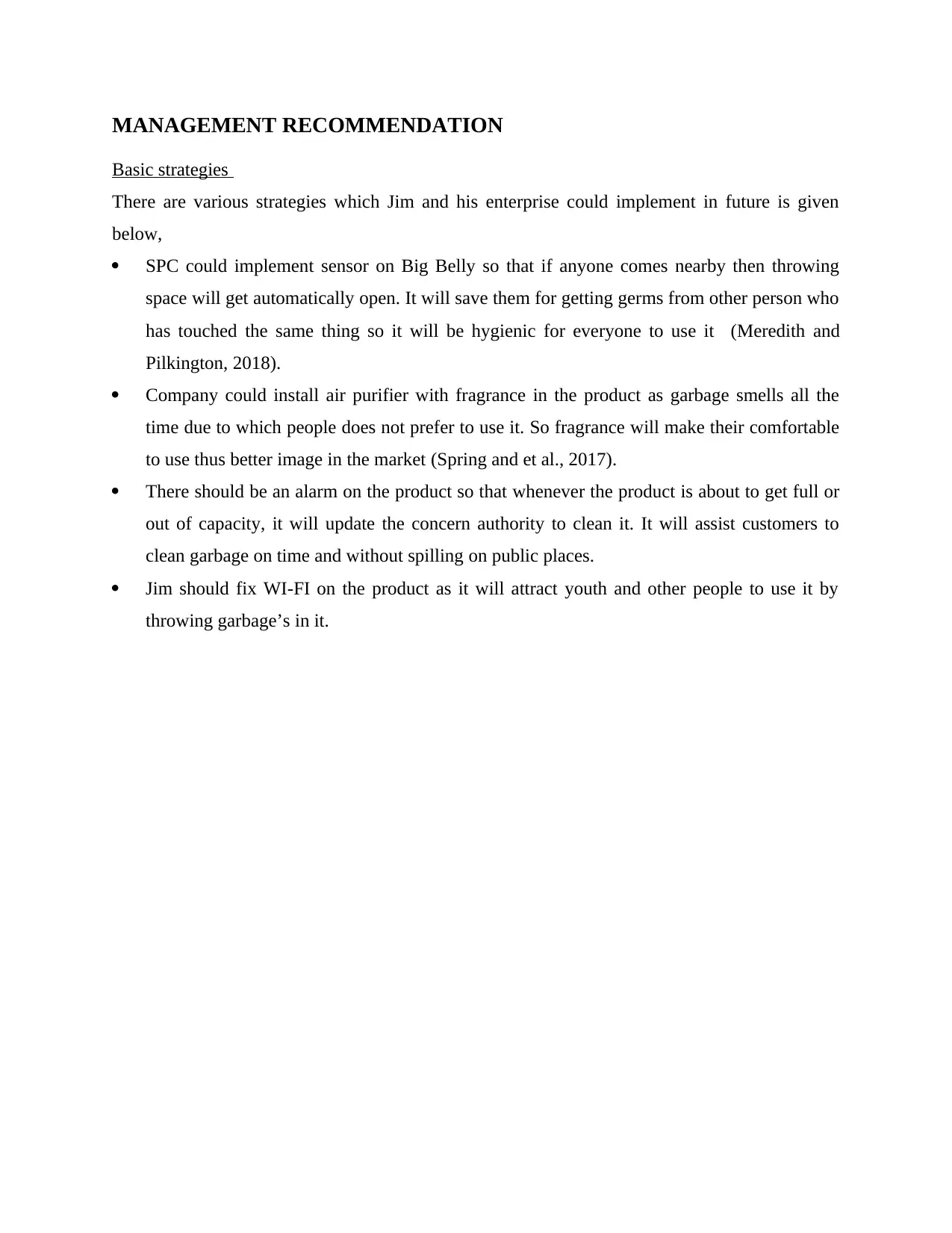
MANAGEMENT RECOMMENDATION
Basic strategies
There are various strategies which Jim and his enterprise could implement in future is given
below,
SPC could implement sensor on Big Belly so that if anyone comes nearby then throwing
space will get automatically open. It will save them for getting germs from other person who
has touched the same thing so it will be hygienic for everyone to use it (Meredith and
Pilkington, 2018).
Company could install air purifier with fragrance in the product as garbage smells all the
time due to which people does not prefer to use it. So fragrance will make their comfortable
to use thus better image in the market (Spring and et al., 2017).
There should be an alarm on the product so that whenever the product is about to get full or
out of capacity, it will update the concern authority to clean it. It will assist customers to
clean garbage on time and without spilling on public places.
Jim should fix WI-FI on the product as it will attract youth and other people to use it by
throwing garbage’s in it.
Basic strategies
There are various strategies which Jim and his enterprise could implement in future is given
below,
SPC could implement sensor on Big Belly so that if anyone comes nearby then throwing
space will get automatically open. It will save them for getting germs from other person who
has touched the same thing so it will be hygienic for everyone to use it (Meredith and
Pilkington, 2018).
Company could install air purifier with fragrance in the product as garbage smells all the
time due to which people does not prefer to use it. So fragrance will make their comfortable
to use thus better image in the market (Spring and et al., 2017).
There should be an alarm on the product so that whenever the product is about to get full or
out of capacity, it will update the concern authority to clean it. It will assist customers to
clean garbage on time and without spilling on public places.
Jim should fix WI-FI on the product as it will attract youth and other people to use it by
throwing garbage’s in it.
Secure Best Marks with AI Grader
Need help grading? Try our AI Grader for instant feedback on your assignments.
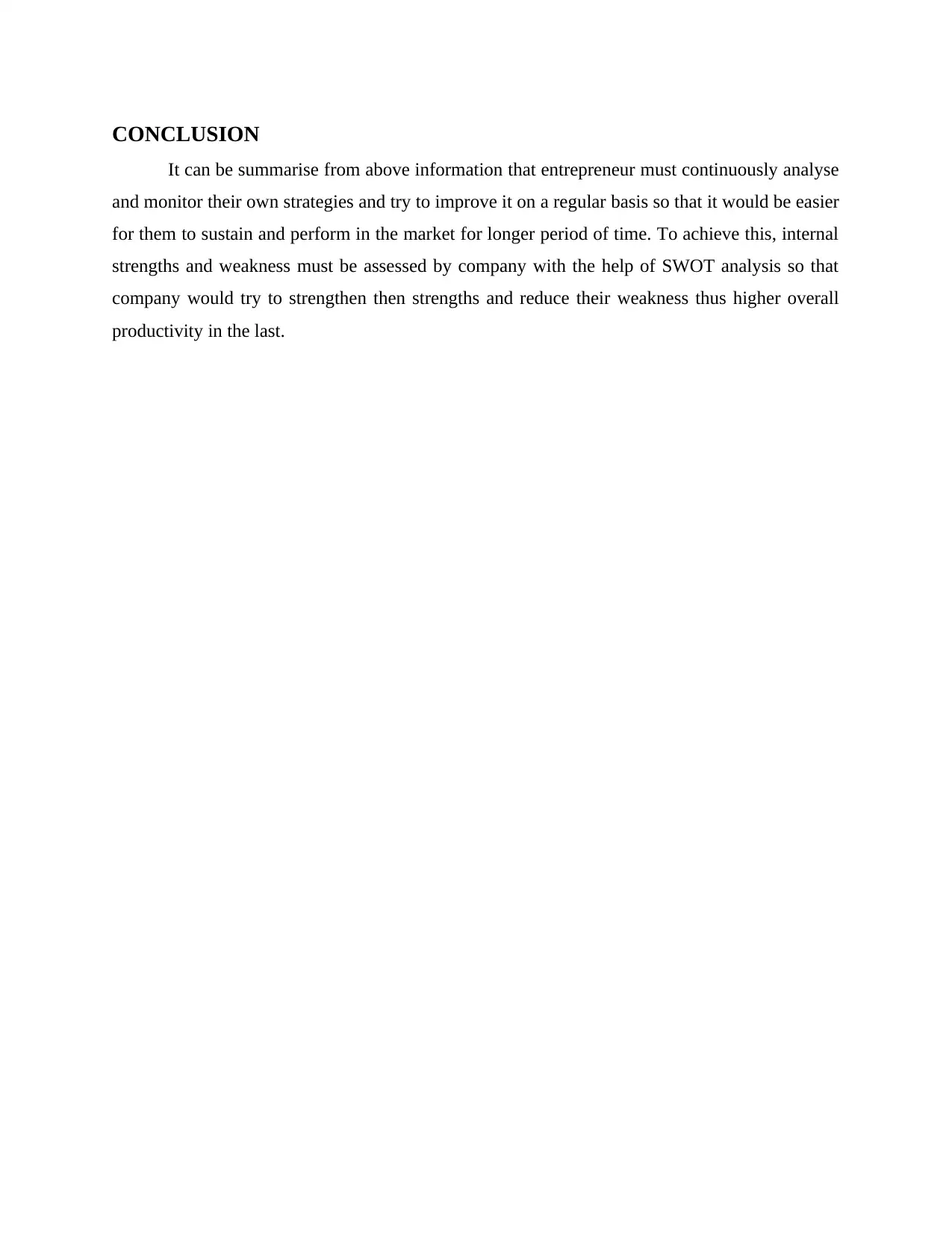
CONCLUSION
It can be summarise from above information that entrepreneur must continuously analyse
and monitor their own strategies and try to improve it on a regular basis so that it would be easier
for them to sustain and perform in the market for longer period of time. To achieve this, internal
strengths and weakness must be assessed by company with the help of SWOT analysis so that
company would try to strengthen then strengths and reduce their weakness thus higher overall
productivity in the last.
It can be summarise from above information that entrepreneur must continuously analyse
and monitor their own strategies and try to improve it on a regular basis so that it would be easier
for them to sustain and perform in the market for longer period of time. To achieve this, internal
strengths and weakness must be assessed by company with the help of SWOT analysis so that
company would try to strengthen then strengths and reduce their weakness thus higher overall
productivity in the last.
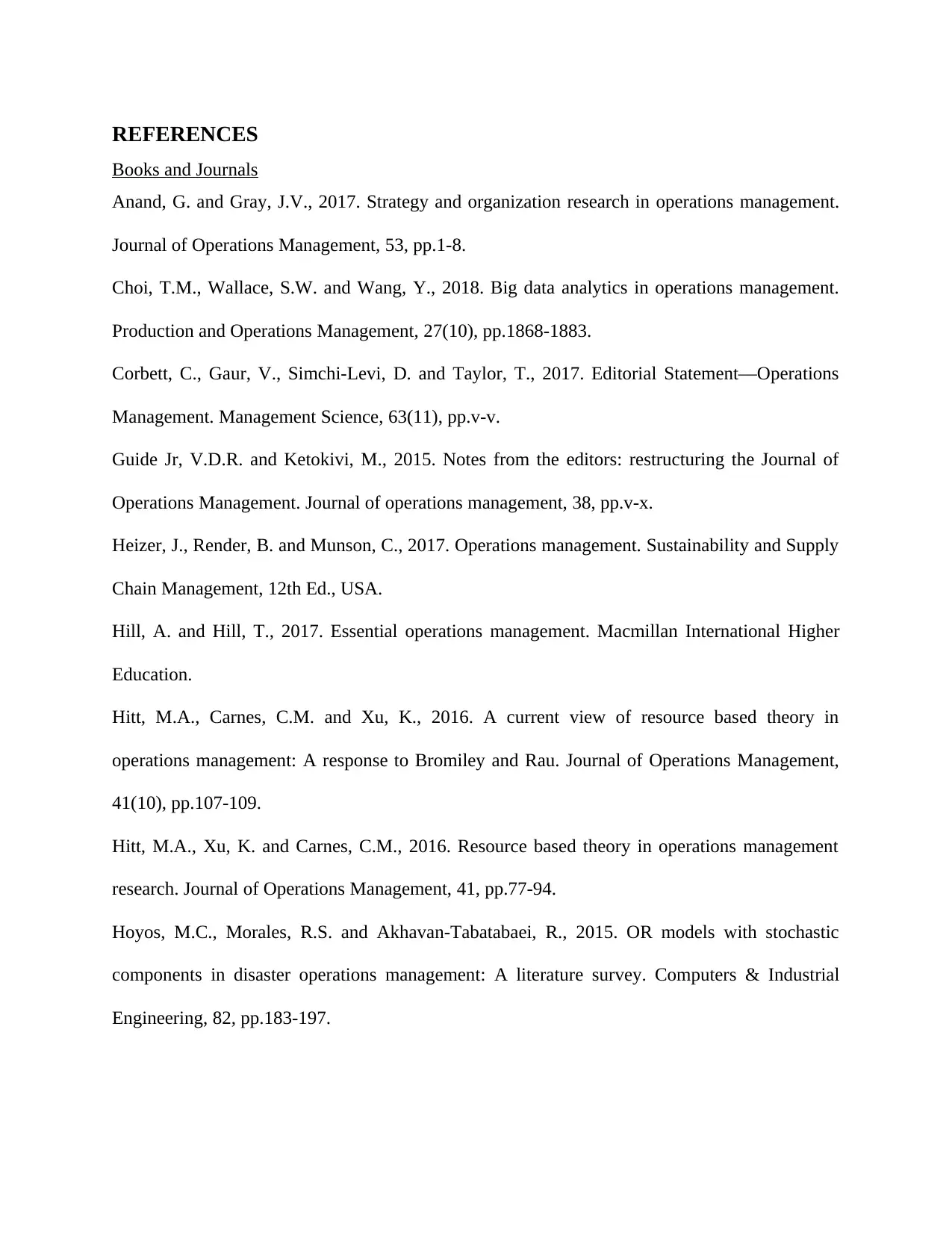
REFERENCES
Books and Journals
Anand, G. and Gray, J.V., 2017. Strategy and organization research in operations management.
Journal of Operations Management, 53, pp.1-8.
Choi, T.M., Wallace, S.W. and Wang, Y., 2018. Big data analytics in operations management.
Production and Operations Management, 27(10), pp.1868-1883.
Corbett, C., Gaur, V., Simchi-Levi, D. and Taylor, T., 2017. Editorial Statement—Operations
Management. Management Science, 63(11), pp.v-v.
Guide Jr, V.D.R. and Ketokivi, M., 2015. Notes from the editors: restructuring the Journal of
Operations Management. Journal of operations management, 38, pp.v-x.
Heizer, J., Render, B. and Munson, C., 2017. Operations management. Sustainability and Supply
Chain Management, 12th Ed., USA.
Hill, A. and Hill, T., 2017. Essential operations management. Macmillan International Higher
Education.
Hitt, M.A., Carnes, C.M. and Xu, K., 2016. A current view of resource based theory in
operations management: A response to Bromiley and Rau. Journal of Operations Management,
41(10), pp.107-109.
Hitt, M.A., Xu, K. and Carnes, C.M., 2016. Resource based theory in operations management
research. Journal of Operations Management, 41, pp.77-94.
Hoyos, M.C., Morales, R.S. and Akhavan-Tabatabaei, R., 2015. OR models with stochastic
components in disaster operations management: A literature survey. Computers & Industrial
Engineering, 82, pp.183-197.
Books and Journals
Anand, G. and Gray, J.V., 2017. Strategy and organization research in operations management.
Journal of Operations Management, 53, pp.1-8.
Choi, T.M., Wallace, S.W. and Wang, Y., 2018. Big data analytics in operations management.
Production and Operations Management, 27(10), pp.1868-1883.
Corbett, C., Gaur, V., Simchi-Levi, D. and Taylor, T., 2017. Editorial Statement—Operations
Management. Management Science, 63(11), pp.v-v.
Guide Jr, V.D.R. and Ketokivi, M., 2015. Notes from the editors: restructuring the Journal of
Operations Management. Journal of operations management, 38, pp.v-x.
Heizer, J., Render, B. and Munson, C., 2017. Operations management. Sustainability and Supply
Chain Management, 12th Ed., USA.
Hill, A. and Hill, T., 2017. Essential operations management. Macmillan International Higher
Education.
Hitt, M.A., Carnes, C.M. and Xu, K., 2016. A current view of resource based theory in
operations management: A response to Bromiley and Rau. Journal of Operations Management,
41(10), pp.107-109.
Hitt, M.A., Xu, K. and Carnes, C.M., 2016. Resource based theory in operations management
research. Journal of Operations Management, 41, pp.77-94.
Hoyos, M.C., Morales, R.S. and Akhavan-Tabatabaei, R., 2015. OR models with stochastic
components in disaster operations management: A literature survey. Computers & Industrial
Engineering, 82, pp.183-197.
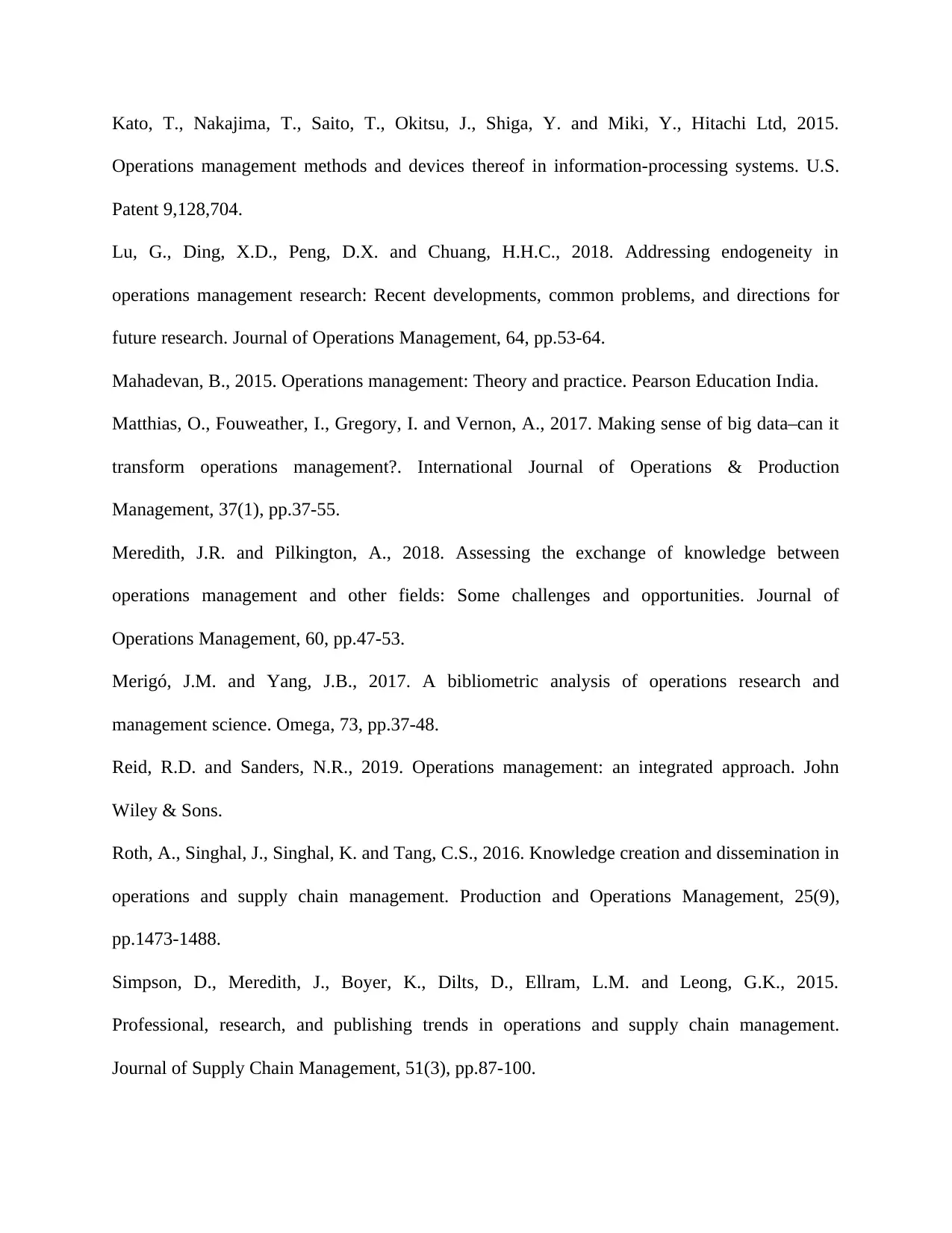
Kato, T., Nakajima, T., Saito, T., Okitsu, J., Shiga, Y. and Miki, Y., Hitachi Ltd, 2015.
Operations management methods and devices thereof in information-processing systems. U.S.
Patent 9,128,704.
Lu, G., Ding, X.D., Peng, D.X. and Chuang, H.H.C., 2018. Addressing endogeneity in
operations management research: Recent developments, common problems, and directions for
future research. Journal of Operations Management, 64, pp.53-64.
Mahadevan, B., 2015. Operations management: Theory and practice. Pearson Education India.
Matthias, O., Fouweather, I., Gregory, I. and Vernon, A., 2017. Making sense of big data–can it
transform operations management?. International Journal of Operations & Production
Management, 37(1), pp.37-55.
Meredith, J.R. and Pilkington, A., 2018. Assessing the exchange of knowledge between
operations management and other fields: Some challenges and opportunities. Journal of
Operations Management, 60, pp.47-53.
Merigó, J.M. and Yang, J.B., 2017. A bibliometric analysis of operations research and
management science. Omega, 73, pp.37-48.
Reid, R.D. and Sanders, N.R., 2019. Operations management: an integrated approach. John
Wiley & Sons.
Roth, A., Singhal, J., Singhal, K. and Tang, C.S., 2016. Knowledge creation and dissemination in
operations and supply chain management. Production and Operations Management, 25(9),
pp.1473-1488.
Simpson, D., Meredith, J., Boyer, K., Dilts, D., Ellram, L.M. and Leong, G.K., 2015.
Professional, research, and publishing trends in operations and supply chain management.
Journal of Supply Chain Management, 51(3), pp.87-100.
Operations management methods and devices thereof in information-processing systems. U.S.
Patent 9,128,704.
Lu, G., Ding, X.D., Peng, D.X. and Chuang, H.H.C., 2018. Addressing endogeneity in
operations management research: Recent developments, common problems, and directions for
future research. Journal of Operations Management, 64, pp.53-64.
Mahadevan, B., 2015. Operations management: Theory and practice. Pearson Education India.
Matthias, O., Fouweather, I., Gregory, I. and Vernon, A., 2017. Making sense of big data–can it
transform operations management?. International Journal of Operations & Production
Management, 37(1), pp.37-55.
Meredith, J.R. and Pilkington, A., 2018. Assessing the exchange of knowledge between
operations management and other fields: Some challenges and opportunities. Journal of
Operations Management, 60, pp.47-53.
Merigó, J.M. and Yang, J.B., 2017. A bibliometric analysis of operations research and
management science. Omega, 73, pp.37-48.
Reid, R.D. and Sanders, N.R., 2019. Operations management: an integrated approach. John
Wiley & Sons.
Roth, A., Singhal, J., Singhal, K. and Tang, C.S., 2016. Knowledge creation and dissemination in
operations and supply chain management. Production and Operations Management, 25(9),
pp.1473-1488.
Simpson, D., Meredith, J., Boyer, K., Dilts, D., Ellram, L.M. and Leong, G.K., 2015.
Professional, research, and publishing trends in operations and supply chain management.
Journal of Supply Chain Management, 51(3), pp.87-100.
Paraphrase This Document
Need a fresh take? Get an instant paraphrase of this document with our AI Paraphraser
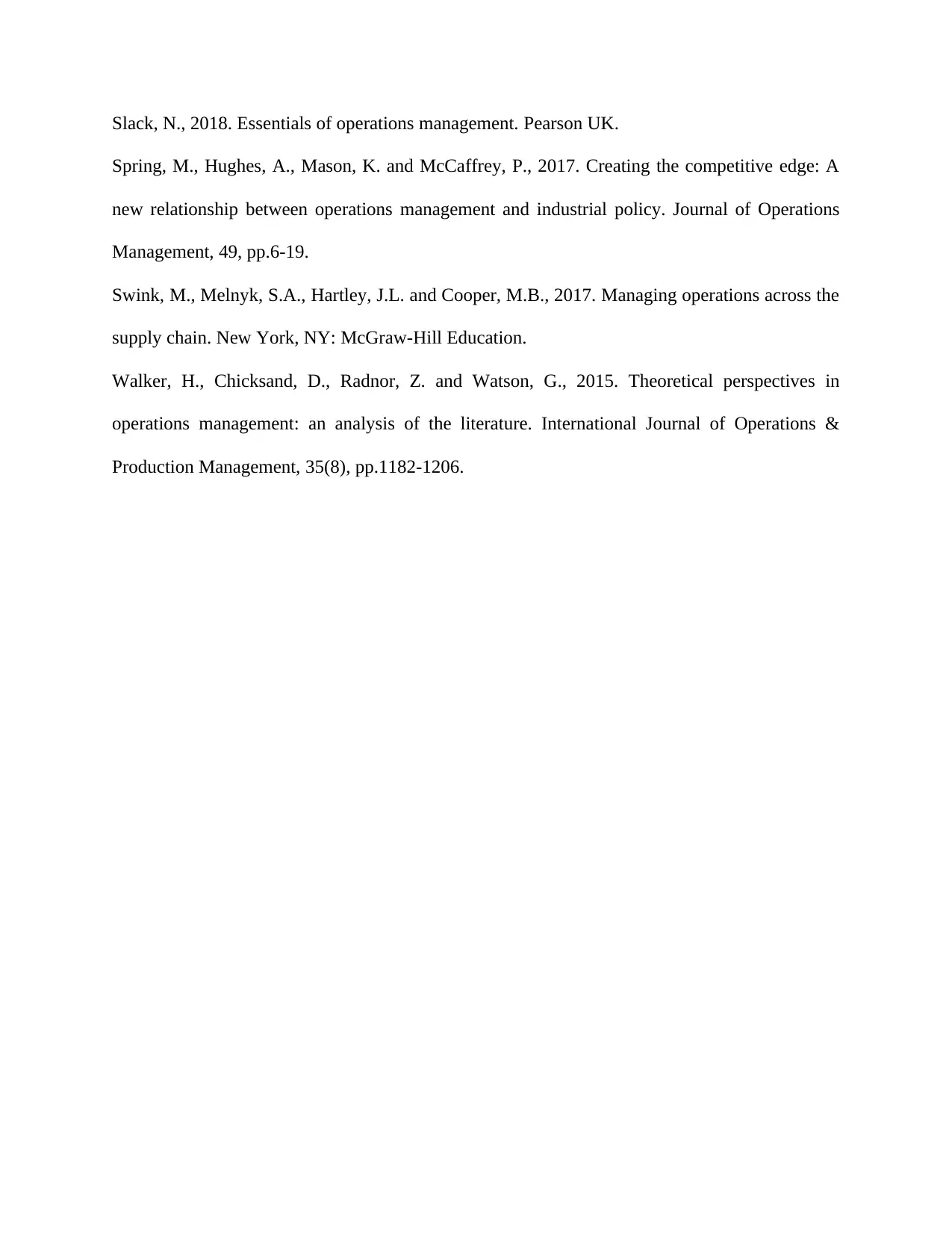
Slack, N., 2018. Essentials of operations management. Pearson UK.
Spring, M., Hughes, A., Mason, K. and McCaffrey, P., 2017. Creating the competitive edge: A
new relationship between operations management and industrial policy. Journal of Operations
Management, 49, pp.6-19.
Swink, M., Melnyk, S.A., Hartley, J.L. and Cooper, M.B., 2017. Managing operations across the
supply chain. New York, NY: McGraw-Hill Education.
Walker, H., Chicksand, D., Radnor, Z. and Watson, G., 2015. Theoretical perspectives in
operations management: an analysis of the literature. International Journal of Operations &
Production Management, 35(8), pp.1182-1206.
Spring, M., Hughes, A., Mason, K. and McCaffrey, P., 2017. Creating the competitive edge: A
new relationship between operations management and industrial policy. Journal of Operations
Management, 49, pp.6-19.
Swink, M., Melnyk, S.A., Hartley, J.L. and Cooper, M.B., 2017. Managing operations across the
supply chain. New York, NY: McGraw-Hill Education.
Walker, H., Chicksand, D., Radnor, Z. and Watson, G., 2015. Theoretical perspectives in
operations management: an analysis of the literature. International Journal of Operations &
Production Management, 35(8), pp.1182-1206.
1 out of 14
Your All-in-One AI-Powered Toolkit for Academic Success.
+13062052269
info@desklib.com
Available 24*7 on WhatsApp / Email
![[object Object]](/_next/static/media/star-bottom.7253800d.svg)
Unlock your academic potential
© 2024 | Zucol Services PVT LTD | All rights reserved.